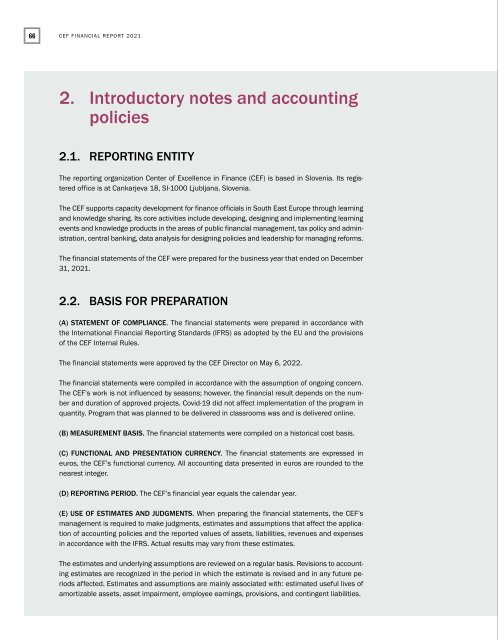CEF Annual report 2021
Create successful ePaper yourself
Turn your PDF publications into a flip-book with our unique Google optimized e-Paper software.
66 <strong>CEF</strong> FINANCIAL REPORT <strong>2021</strong><br />
NOTES TO THE FINANCIAL STATEMENTS 67<br />
2. Introductory notes and accounting<br />
policies<br />
2.1. REPORTING ENTITY<br />
The <strong>report</strong>ing organization Center of Excellence in Finance (<strong>CEF</strong>) is based in Slovenia. Its registered<br />
office is at Cankarjeva 18, SI-1000 Ljubljana, Slovenia.<br />
The <strong>CEF</strong> supports capacity development for finance officials in South East Europe through learning<br />
and knowledge sharing. Its core activities include developing, designing and implementing learning<br />
events and knowledge products in the areas of public financial management, tax policy and administration,<br />
central banking, data analysis for designing policies and leadership for managing reforms.<br />
The financial statements of the <strong>CEF</strong> were prepared for the business year that ended on December<br />
31, <strong>2021</strong>.<br />
2.2. BASIS FOR PREPARATION<br />
(A) STATEMENT OF COMPLIANCE. The financial statements were prepared in accordance with<br />
the International Financial Reporting Standards (IFRS) as adopted by the EU and the provisions<br />
of the <strong>CEF</strong> Internal Rules.<br />
The financial statements were approved by the <strong>CEF</strong> Director on May 6, 2022.<br />
The financial statements were compiled in accordance with the assumption of ongoing concern.<br />
The <strong>CEF</strong>’s work is not influenced by seasons; however, the financial result depends on the number<br />
and duration of approved projects. Covid-19 did not affect implementation of the program in<br />
quantity. Program that was planned to be delivered in classrooms was and is delivered online.<br />
(B) MEASUREMENT BASIS. The financial statements were compiled on a historical cost basis.<br />
(C) FUNCTIONAL AND PRESENTATION CURRENCY. The financial statements are expressed in<br />
euros, the <strong>CEF</strong>’s functional currency. All accounting data presented in euros are rounded to the<br />
nearest integer.<br />
(D) REPORTING PERIOD. The <strong>CEF</strong>’s financial year equals the calendar year.<br />
(E) USE OF ESTIMATES AND JUDGMENTS. When preparing the financial statements, the <strong>CEF</strong>’s<br />
management is required to make judgments, estimates and assumptions that affect the application<br />
of accounting policies and the <strong>report</strong>ed values of assets, liabilities, revenues and expenses<br />
in accordance with the IFRS. Actual results may vary from these estimates.<br />
The estimates and underlying assumptions are reviewed on a regular basis. Revisions to accounting<br />
estimates are recognized in the period in which the estimate is revised and in any future periods<br />
affected. Estimates and assumptions are mainly associated with: estimated useful lives of<br />
amortizable assets, asset impairment, employee earnings, provisions, and contingent liabilities.<br />
2.3. SIGNIFICANT ACCOUNTING POLICIES<br />
The <strong>CEF</strong> has consistently applied the accounting policies to all periods presented in its financial<br />
statements.<br />
(A) FOREIGN CURRENCY<br />
Foreign currency transactions<br />
Foreign currency transactions are converted into the functional currency of the <strong>CEF</strong> using the<br />
exchange rate applied on the day they arise. Cash, cash equivalents and liabilities denominated<br />
in foreign currencies are converted into the functional currency using the exchange rate applicable<br />
at the end of the <strong>report</strong>ing period. Positive or negative exchange differences are differences<br />
between the amortized cost in the functional currency at the beginning of the period, increased<br />
or decreased by the amount of applicable interest and payments in the period, and the amortized<br />
cost expressed in foreign currency, converted using the exchange rate at the end of the period.<br />
Exchange rate differences are recognized in the income statement.<br />
The ECB’s reference exchange rates and the Bank of Slovenia’s monthly exchange rates for currencies<br />
for which the ECB does not publish reference exchange rates are used to convert receivables<br />
denominated in foreign currencies<br />
(B) FINANCIAL INSTRUMENTS<br />
Non-derivative financial assets<br />
Receivables and deposits are initially recognized on the day they arise. Financial assets are<br />
derecognized when the contractual rights to cash flows from these assets expire, or when the<br />
<strong>CEF</strong> transfers the rights to cash flows from financial assets based on a transaction that involves<br />
the transfer of all risks and benefits associated with the ownership of the financial asset.<br />
Depending on their maturity, they are classified as current financial assets (maturity of up to 12<br />
months from the date of the statement of financial position) or non-current financial assets (maturity<br />
of more than 12 months from the date of the statement of financial position). Deposits and<br />
receivables are recognized initially at fair value plus any directly attributable transaction costs.<br />
Subsequent to initial recognition, they are measured at amortized cost using the effective interest<br />
method, less any impairment losses.<br />
Receivables<br />
Loans and receivables are non-derivative financial assets with fixed or determinable payments<br />
not quoted on an active market. They are initially recognized at fair value and increased by any direct<br />
transaction costs. After initial recognition, loans and receivables are measured at amortized<br />
cost using the effective interest rate method, less any impairment losses. Loans and receivables<br />
include operating and other receivables.<br />
The <strong>CEF</strong> does not invest in non-derivative financial assets with fixed or determinable payments.<br />
The <strong>CEF</strong> checks the materiality of disclosed receivables at least once a year. Receivables, for<br />
which there exists the possibility that they will not be settled in part (or not at all) within 180 days<br />
of maturity, are generally deemed as doubtful. The <strong>CEF</strong> creates an allowance for doubtful and<br />
disputed receivables in an amount equal to 100%, which is charged to revaluation expenses. <strong>CEF</strong><br />
did not make material changes to impairment policy for undue receivables as IFRS 9 requires, as<br />
the effects are immaterial.

















